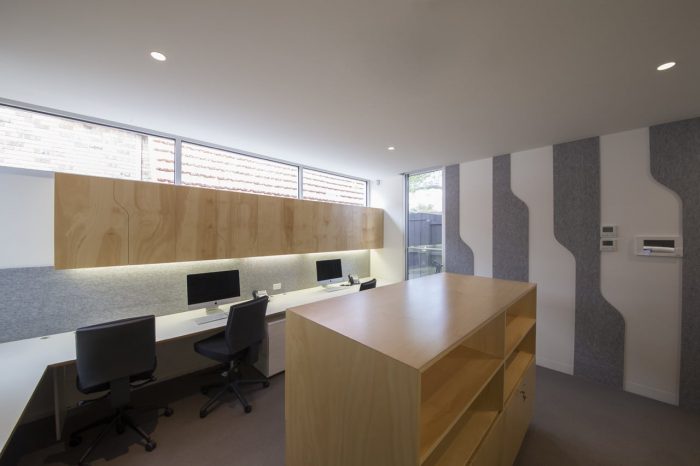该项目是对诺克斯骨科集团现有诊室的翻新和扩建,毗邻诺克斯医院。主入口通过诺克斯医院的停车场,后入口在一条住宅街内。项目简介是扩展现有的行政空间和接待区,并增加两个咨询室。
The project is a renovation & extension the existing consulting rooms for Knox Orthopaedic Group, adjacent to Knox hospital. The main entry is via the Knox hospital car park, with the rear entry within a residential street. The brief was to extend the existing administration spaces and reception area and add 2 additional consulting rooms.
开发的方案包括为外科医生提供咨询室,并为咨询后的工作提供了一个公共的热台触摸区。行政办公室可容纳辅助人员,大型厨房和室外平台可让团队一起吃午饭和工作后的聚会。接待区扮演着双重角色,既是等候区,又是团体正念课程的研讨空间,这是病人康复过程中的一个重要组成部分。
一个关键的考虑因素是增加自然光和通风,并从工作区发展出与新花园区域的视觉联系。原本一般的内部空间与外部没有联系,现在变成了充满光线和自然通风的空间,大大减少了对人工照明和通风的依赖,员工也更加快乐和健康。
The programme developed includes consulting rooms for the surgeons, with a communal hot desk touch down area for post consultation work. The administration office accommodates the support staff and a large kitchen and outdoor deck allows the team to come together for lunch and post work get togethers. The reception area plays a dual role of waiting area as well as a workshop space for group mindfulness classes, which are an important component of the recovery process for the patients.
A key consideration was to increase access to natural light and ventilation and develop a visual connection to the new garden areas from the workspaces. What were originally generally internalised spaces with no connection to the exterior have now become light filled and naturally ventilated spaces, with a significant reduction on the reliance for artificial light and ventilation, and happier and healthier staff.
骨科和建筑有一种共生的关系。矫形外科医生的工具、过程和语言与木匠的方式是一致的。建筑设计与假肢和外科技术的设计之间也有相似之处,3D建模和打印是他们研发过程中的常见做法。
我们的设计方法是在建筑形式上强调各学科之间的相似性。分层的外墙参考了工具、假肢和人体框架。
Orthopaedics and architecture have a symbiotic relationship. The tools, process and the language of the orthopaedic surgeon is aligned with the ways of the carpenter. There are also parallels between architectural design and the design of prosthetics and surgical techniques, with 3d modelling and printing a common practice in their R&D processes.
Our design approach was to emphasise the parallels between the disciplines in the built form. The layered façade references the tools, prosthetics and the human frame.
该设计在X射线的二维和三维质量之间创造了相互作用,X射线是外科医生的另一个基本分析工具。外立面强调了X光片的薄度,同时通过分层薄膜、钢和回收塑料的形式发展出一种深度。当它被室内的灯光照亮时,立面模仿了灯箱上的X光的视觉质量。
内部延伸了立面的三维品质和光线的相互作用。回收的塑料隔音板加强了立面投下的阴影,将X射线的虚拟世界延伸到室内。
The design creates interplay between the 2 dimensional and 3 dimensional qualities of the X-ray, another essential analytical tool of the surgeon. The façade emphasises the thinness of an X-ray sheet, while developing a depth through layering film, steel and recycled plastic forms. As it is backlit by the interior, the façade mimics the visual qualities of the X-ray on a lightbox.
The interior extends the 3 dimensional qualities and interplay of light achieved in the façade. The recycled plastic acoustic panelling reinforces the shadows cast by the façade, extending the virtual world of the X-ray into the interior.
接待台通过在分层胶合板块上雕刻出立面中的假肢,进一步发展了三维的品质。雕刻出来的元素然后被连接起来形成长椅,确保所有的胶合板都被使用。
新的扩展部分具有高度的雕塑感,同时解决了咨询室的实用性要求。除此之外,增加自然环境的好处是使员工有更大的幸福感,并减少服务成本。
The reception desk then develops the 3 dimensional qualities further by carving the prosthetics seen in the façade out of the layered plywood block. The carved elements removed are then connected to form the bench seat, ensuring all the plywood is used.
The new extension is highly sculptural while addressing the pragmatic requirements of the consulting rooms. In addition to this, the benefits of increased natural amenity have resulted in a greater sense of wellbeing by the staff and reduced services costs.
Architects: FMD Architects
Year : 2014
Photographs :John Gollings
Services Engineer : BRT Consulting
Structural Engineer : Macleod Consulting
Builder : Malin Construction P/L
Town Planner : Urbis
Building Surveyor : Wilsmore Nelson Group
Landscape Architect : Katherine Rekaris
Design Team : Fiona Dunin, Andrew Carija, Robert Kolak, Owen Castley
City : Melbourne
Country : Australia










